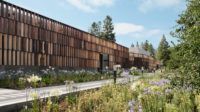Seoul, South Korea
How did a phone call to Paris launch an architecture firm in Seoul? “It was kind of destiny,” says JOHO Architecture principal Jeonghoon Lee. He had been studying and practicing architecture in Europe for seven years when a relative from his native Korea contacted him. The man was working on a project, but had fired the architect. He needed someone he could trust. Lee agreed to take on the job—the Herma Parking Building in Yongin, a city 25 miles outside of Seoul. He soon found that managing it from Paris was too difficult, so he moved to Seoul and set up JOHO Architecture in 2009. That first commission led to more, and now JOHO has five completed projects and seven designers on staff.
The name JOHO has two sources. It's a nickname Lee used in France, since it was easier than Jeonghoon for his classmates to pronounce. And in Korean, “jo” means “constructing” and “ho,” “liking.” “Enjoy Construction” is a good fit for a firm that focuses on material explorations. Lee uses wood, brick, and metal in their raw forms. “I want to explore the essence of the material,” he says. But by employing common elements in uncommon ways, he produces unexpected results. For the Namhae Cheo-ma House, for example, he connected 500 pieces of 11.5-foot aluminum louvers—standard pieces made for fences—into a curving facade. For Egg 333 he took off-the-shelf wood louvers, split them in two, and fitted them over the existing brick facade of a residential building. These and JOHO's other projects repeat materials in layers to create sculptural surfaces.
Lee's design focus comes in part from his graduate degree in architectural materials from the School of Architecture of Nancy (EAN). He recalls the impact that class trips to glass factories and lumber mills had on him. Another influence was working for Shigeru Ban on the Centre Pompidou'Metz, known for its innovative glue-laminated timber roof and fiberglass facade. Lee shares Ban's interest in inexpensive materials—a necessity, he says, for young architects working with small budgets.
In its contemporary designs, JOHO offers playful takes on traditional Korean motifs: the curved cheoma (eaves) of a tiled roof, the open daecheong-maru (front hall) of a traditional house, the byeongpung (folding screens) used as room dividers. Lee borrows these elements and abstracts them in his work. While it has been easy for him to take on Korean cultural references, it has been more difficult to adjust to the local way of building. “I didn't know the Korean construction reality because I studied in France and practiced in European offices,” he says. He has had to learn a lot by working on-site, a task that has been difficult but rewarding. Enjoying construction, after all, is Lee's destiny.
JOHO Architecture
FOUNDED: 2009
DESIGN STAFF: 7
PRINCIPALS: Jeonghoon Lee
EDUCATION: Lavillette School of Architecture, M.A., 2007; School of Architecture of Nancy, M.A., 2004; SungKyunKwan University, B.A., 2000
WORK HISTORY: Zaha Hadid Architects, 2008'9; Agence Moatti et Rivière, 2007'8; Shigeru Ban Architects Europe Office, 2004'5
KEY COMPLETED PROJECTS: Curving House, Yongin, 2012; Egg 333, Seoul, 2012; Namhae Cheo-ma House, Namhae-gun, 2011; Herma Parking Building, Yongin, 2010
KEY CURRENT PROJECTS: Yin Yang House, Seongnam, 2013; Gangnam Nonhyeon Cultural Center, Seoul, 2014; Baemi Wedding Hall, Pyeongtaek, 2014
WEB SITE: www.Johoarchitecture.com














